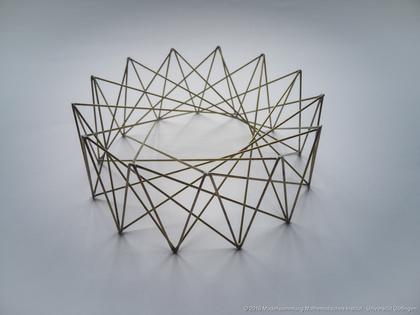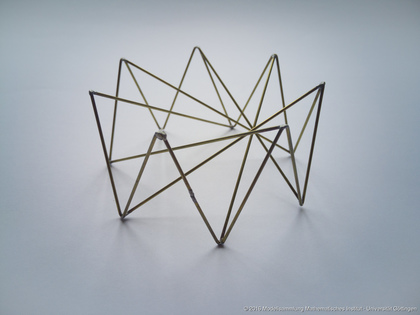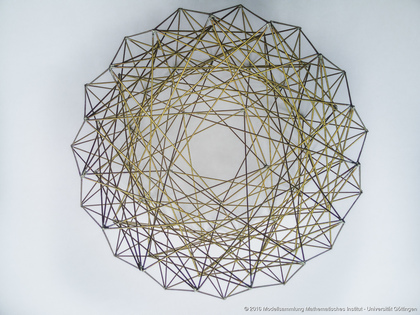Bruhat-Tits building
Model 958
| | |
| Constructor: | Category: |
| Karsten Roeseler et al. | |
Description
Bruhat-Tits building, constructed 2004/05. Item on loan 2016.
Additions
The models illustrate the combinatorial structure and symmetry of certain Bruhat-Tits buildings.
(1) Bruhat-Tits building associated to $GL_3$ over the field $\mathbb{F}_2$ with 2 elements.
(2) Bruhat-Tits building associated to $GL_3$ over the field $\mathbb{F}_3$ with 3 elements.
(3) Bruhat-Tits building associated to $GL_4$ over the field $\mathbb{F}_2$ with 2 elements.
Here is one possible description of what the models illustrate: Each vertex (i.e. each point in which some wires are joined) stands for a nontrivial vector subspace of a given vector space; for (1) it is $\mathbb{F}_2^3$, for (2) it is $\mathbb{F}_3^3$, and for (3) it is $\mathbb{F}_2^4$. Each edge (wire segment) stands for a relation "is contained in". For (1) and (2) one should think of the upper level of vertices as the set of all one-dimensional subspace (quantity: 7 resp. 13); the vertices in the lower level are then all two-dimensional subspaces (quantity: also 7 resp. 13). In model (3), in the uppermost level there are the 15 one-dimensional subspaces, in the middle there are the 35 two-dimensional, and in the lower level the are the 15 three-dimensional subspaces shown.
As buildings, the models especially consist of so-called chambers. For models (1) and (2), each wire segment represents one chamber—associated with this is a pair consisting of a one- and a two-dimensional subspace where the first one is a subspace of the latter one. For model (3) one considers analogous chains (in general such a chain is called a flag) of three subsequently contained vector subspaces; they become a triangle of wire segments with vertices in all three levels, where for clarity's sake the connections from the first to the third level are not shown.
Some substructures of buildings are of special interest, especially apartments. In models (1) and (2) these are six chambers (wire segments) which are connected in a circular way. For example, in model (1) there are 28 such apartments. In model (3) apartments consist of structures made of 48 triangles.
Due to the structure of the apartments (1) und (2) represent buildings of type $\mathsf{A}_2$, and (3) is a building of type $\mathsf{A}_3$.
Showcase of this model is Case number 26




